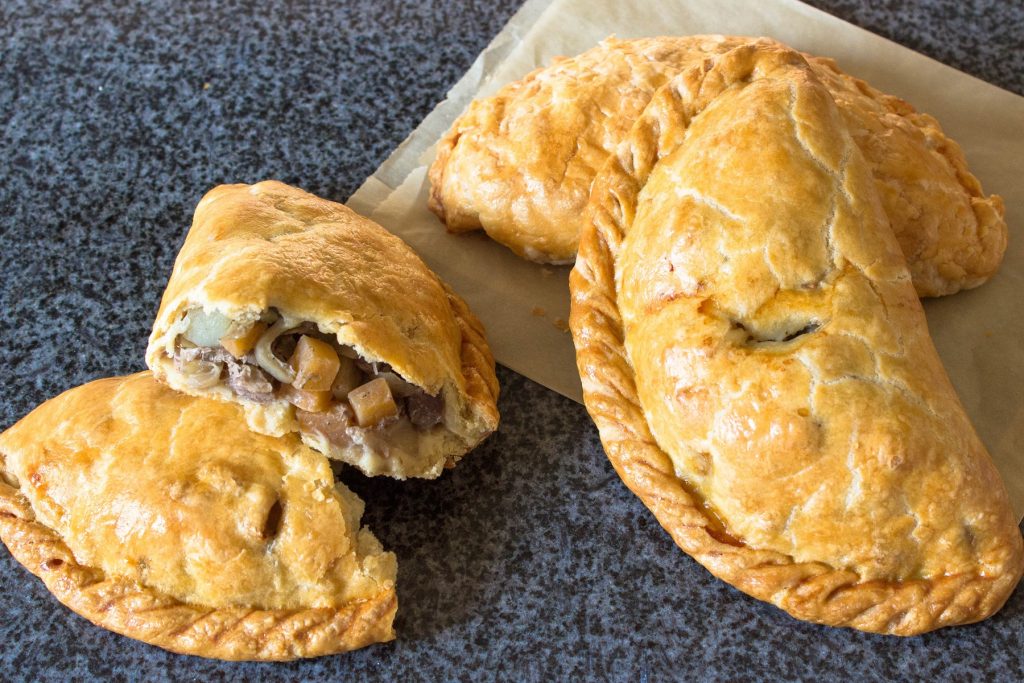If you have ever been on holiday to Cornwall, it’s highly likely that you will have sampled the very famous Cornish Pasty while you were there!
But did you know just how easy (and cheaply) an authentic Cornish Pasty can be made at home?
What Makes A Pasty Cornish?
Well, having said that, of course a pasty cannot truly be called ‘Cornish’ unless it has been made in Cornwall. It has been awarded PGI (Protected Geographical Indication) Status, which means a genuine Cornish Pasty will have been prepared within Cornwall’s borders and nowhere else.
Simple Ingredients
It also means that only certain ingredients can be used, namely diced or minced beef, diced or sliced potato, swede, onion and seasoning.
The pastry can be either shortcrust, puff or rough puff but it does need to be robust enough not to break when the pasty is handled. This is one of the great characteristics of a pasty and makes them perfect for outdoor eating. A pasty will withstand a hiking trip or seaside picnic quite happily!
The only other rules when making Cornish pasties are that the filling must be uncooked when the pasty is assembled and the crimping must be on the side (not over the top). The pasty is then finished with an egg wash to glaze.
Our Recipe
We’ve made many pasties in our time but the simplicity of this Authentic Traditional Cornish Pasty recipe has been a winner every time.
Give them a try!
Easy Authentic Traditional Cornish Pasty Recipe

A delicious and easy recipe for traditional Cornish Pasties. Simple, tasty ingredients encased in a robust pastry case makes these pasties perfect for lunch on the go!
Pastry
- 500 grams strong white flour (aka Bread Flour)
- 100 grams white vegetable fat (or lard if preferred)
- 150 grams butter (or block cooking margerine)
- 1 tsp salt
- 175 ml cold water
Pasty filling
- 400 grams frying steak, aka skirt beef (diced 1cm thick)
- 400 grams potatoes, peeled (sliced or diced 1cm thick)
- 200 grams swede, peeled (diced 1cm thick)
- 220 grams onions (diced)
- 1 tsp salt
- 1 tsp ground black pepper
Glaze
- 1 egg, beaten
To make the pastry
- Put the flour into a large bowl with the salt and rub in the vegetable fat and butter until the mixture resembles fine breadcrumbs.
-
Add most of the water and mix with a knife until the dough starts to come together.
Add more water if the pastry feels dry but not too much as you don’t want a wet and sticky dough.
-
Cover the pastry with cling film or put into a polythene bag and leave it to rest in the fridge for at least half an hour.
For the filling
-
In another large bowl, mix together well all of the ingredients except the egg and leave to stand until you are ready to assemble the pasties.
Assembling the pasties
-
Roll out the chilled pastry to 4mm thick. Cut circles from the pastry using a tea plate or side plate as a guide. You can make them any size you want but you may as well have something you can get your teeth into! My tea plates measure 19cm across so if you use this size you will get 6 large pasties from this amount of pastry.
-
Divide the filling into 6 equal portions. These should be roughly about 200 grams each.
-
Pile a portion of the filling onto the centre of one of the circles of pastry.
-
Brush the beaten egg around the edge of half of the circle of pastry then bring the other half over the filling to enclose it and seal the edges together.
-
Press the edges together firmly then crimp the edges in the classic rope style to seal everything inside.
(I will add a short video on how to do this very soon – it’s very easy to do!)
-
Glaze with the egg wash and put onto a baking sheet lined with parchment paper.
Do the same with the other circles of pastry – you may need 2 baking sheets.
-
Bake the pasties in the centre of a pre heated warm oven – gas 4 / 180°c / 350°f / 160°c Fan for 1 hour or until nicely golden brown.
When cooked, place onto a wire rack to cool before devouring still slightly warm – delicious!

